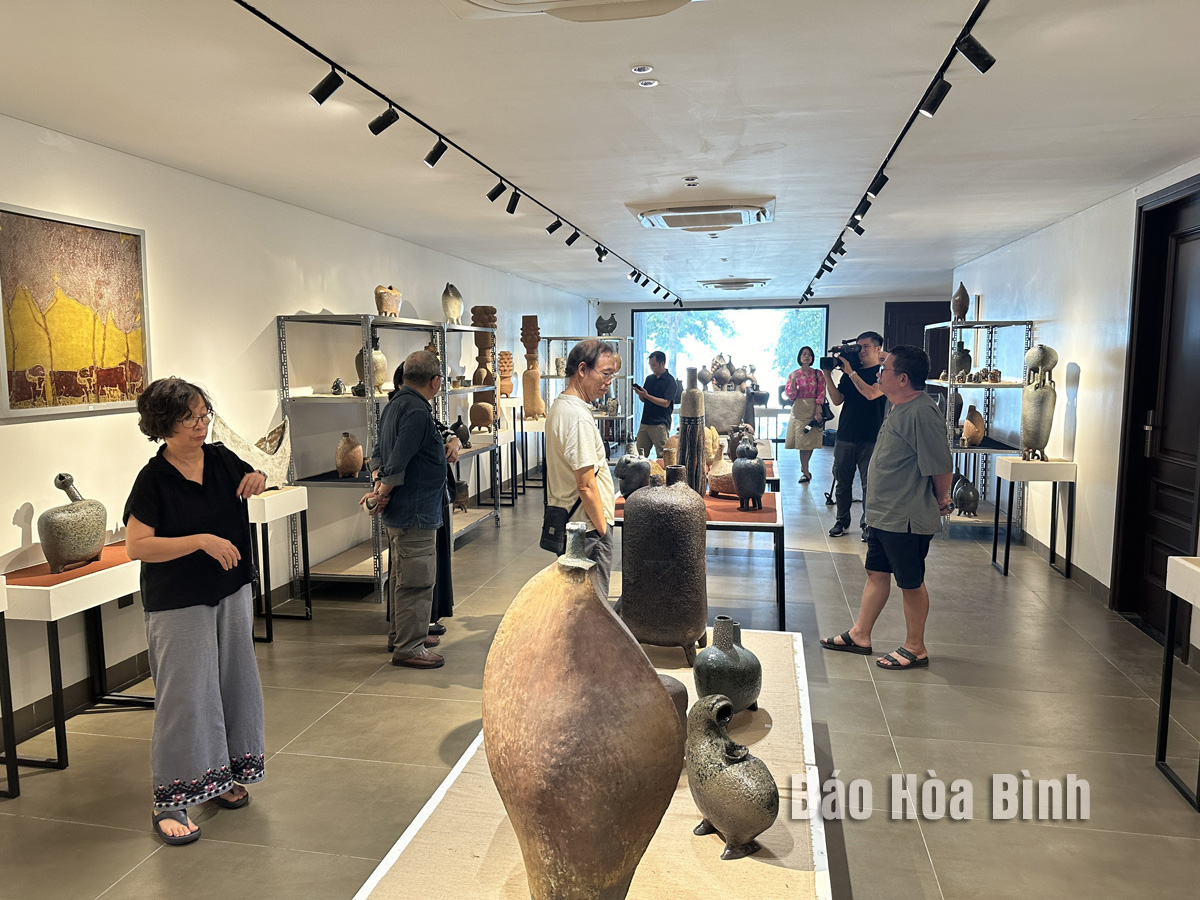
In a bid to preserve and introduce Muong culture to a wider audience across the country, in August, artist Vu Duc Hieu officially brought to the capital city pottery works inspired by the Muong ethnic community in Hoa Binh province by creating a rich cultural space at 85 Nhat Chieu street in Tay Ho district.
Over 130 Muong-inspired pottery works displayed at 85 Nhat Chieu street in Tay Ho district of Hanoi.
The special pottery line came into existence in September 2014 when Hieu chose the name of "Gom Muong (Muong pottery)” for his related workshop and ceramic works completed at the Muong Cultural Space Museum at 202 Tay Tien Street, Thai Binh ward, Hoa Binh city.
Unlike other ceramics on the market, the line does not follow any preset patterns, drawing inspiration mainly from the history, culture, members, and land of the Muong ethnic community in Hoa Binh. Remarkably, over 90% of the materials used in crafting and firing the pottery, such as clay, ash glaze additives, and other distinctive ingredients, are sourced locally, particularly from the areas surrounding the museum. Each Muong-inspired pottery piece embodies the soul and emotions of the artist, narrating stories of the Muong culture and its people.
Art researcher Vu Huy Thong remarked, from the raw materials of the earth, through the skilled hands of the artists, the pottery transcends the limits of materials, becoming a unique art form that reflects the blend of tradition and modernity as well as the local and the global traits.
Talking about his passion, Hieu shared, "As an artist, I want culture and art to develop together and use cultural history to create artistic stories. Over the past decade, we've regularly organised workshops and art festivals, both at home and abroad to introduce our Muong pottery. Beyond fostering exchanges and learning, my greatest hope is that artists will explore the local culture of the Muong people and Vietnamese culture at large".
He noted that when artists find inspiration there and produce their art, they help extend the Muong culture to communities at home and abroad.
After ten years of tireless efforts, his pottery line has made significant strides, gradually establishing a name in the Vietnamese ceramic industry. In 2014, its first pieces were showcased at an exhibition at 83 Xuan Dieu, Hanoi. In 2017, a related workshop brought together over 30 sculptors and painters passionate about ceramics from various places to create works on-site, leaving behind valuable experiences, new methods, and high-quality products.
To bring Muong-inspired pottery closer to art lovers in Hanoi, the "Mo xuong gom Muong (Opening the Muong pottery workshop)" event in August 2024 was meticulously prepared by Hieu and his colleagues, marking the 10th anniversary of the workshop’s operations and displaying more 130 selected works from various artists at the workshop over the past decade.
Hoa Binh province has carried out multiple programmes and initiatives to revive its cultural heritage which has gradually fallen into oblivion through the ebbs and flows of history.
The most prominent and defining feature in the prehistoric era of Hoa Binh is the Hoa Binh Culture. The Culture was first discovered in Hoa Binh. The significant prehistoric culture represents not only Vietnam but also Southeast Asia and southern China. Through excavations of cave sites in the limestone regions of Hoa Binh, French archaeologist M. Colani introduced the world to a "Stone Age in Hoa Binh province – Northern Vietnam" in 1927. On January 30, 1932, the First Congress of Far Eastern Prehistorians, held in Hanoi, officially recognised the Hoa Binh Culture.
Known as the "Land of Epic History”, Hoa Binh province, the gateway to Vietnam’s northwest, boasts a strategic location and a unique cultural tapestry woven by its ethnic minority communities.
The People's Committee of Luong Son District recently held a ceremony to receive the certificate recognizing Sau Communal House in Thanh Cao Commune as a provincial-level historical and cultural site.
Recognising the importance of cultural heritage preservation in protecting and promoting the value system of Vietnamese culture, and serving socio-economic development in the new period, Party committees and local administrations in Hoa Binh province have identified it as a key task in the cultural development strategy. The province has been making efforts in mobilising resources, creating consensus among people and engaging ethnic communities in preserving and promoting cultural identity.
Hoa Binh province has captured growing attention both domestically and internationally for its distinctive cultural heritage and rich history. Most notably, it has been renowned for its famous Hoa Binh culture, considered the cradle of ancient Vietnamese civilisation. Looking ahead to significant milestones in 2025 and the 140th anniversary of province establishment in 2026, Hoa Binh Newspaper presents a comprehensive overview of the province's development across economic, social, cultural, tourism, and security domains.



